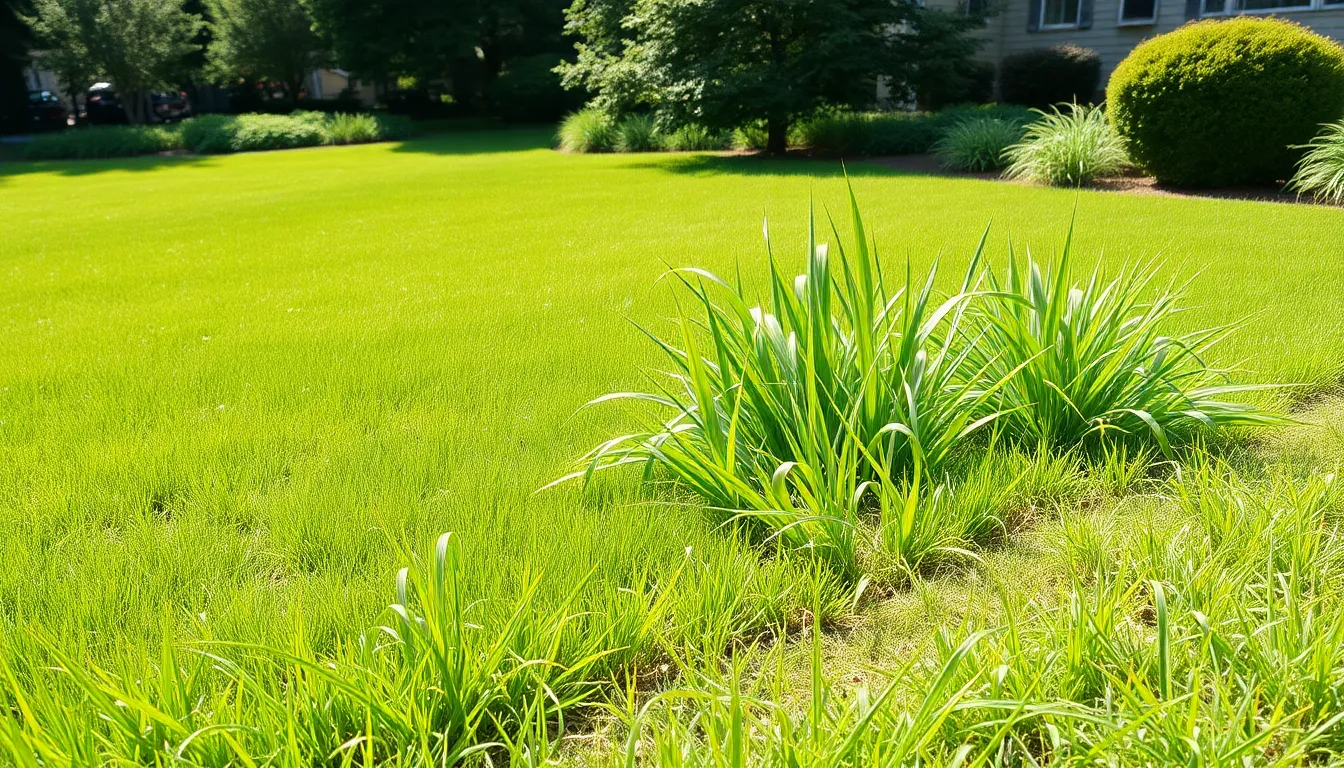Fescue grass is a popular choice for lawns and landscapes, known for its adaptability and resilience. Its lush green blades create a vibrant carpet that enhances outdoor spaces, making it a favorite among homeowners and landscapers alike. Understanding what fescue grass looks like can help in identifying it and appreciating its unique characteristics.
Typically, fescue grass features narrow, elongated leaves that can range in color from deep green to a lighter hue, depending on the variety. Its texture is often soft and dense, providing a pleasant feel underfoot. With its ability to thrive in various climates, fescue grass not only offers aesthetic appeal but also contributes to a healthy lawn environment.
Table of Contents
ToggleCharacteristics of Fescue Grass
Fescue grass features distinct characteristics that contribute to its overall appeal and functionality. Its leaf structure and color variations play significant roles in defining its look and performance.
Leaf Structure
Fescue grass displays narrow, elongated leaves that can reach lengths of 6 to 12 inches. The texture of these leaves is typically fine and soft, giving the grass a lush appearance. Leaf blades often grow in clumps and form a dense mat, which contributes to the lawn’s overall sturdiness and aesthetic appeal. The fibrous root system promotes drought resistance and enhances its adaptability to various soil types.
Color Variations
Fescue grass presents varying color shades, ranging from deep green to blue-green. The deeper color shades often indicate healthy growth, while lighter colors may suggest stress or nutrient deficiencies. Some fescue varieties, such as tall fescue, exhibit a rich, dark green hue, creating a vibrant carpet-like effect on lawns. The color can also change with seasons, with more intense shades emerging during the peak growing months of spring and fall, further enhancing the lawn’s visual impact.
Types of Fescue Grass

Fescue grass includes several distinct varieties, each with unique characteristics and optimal uses in landscaping and lawn care.
Tall Fescue
Tall fescue features robust, thick blades that can grow 12 to 36 inches tall. It has a deep root system, often extending 3 to 4 feet, which enhances drought resistance. This variety thrives in transitional climates and tolerates heat, making it suitable for regions with varying moisture levels. Tall fescue’s texture ranges from coarse to slightly soft, and its color is typically dark green. This grass type is ideal for high-traffic areas due to its durability and resilience.
Fine Fescue
Fine fescue consists of several species, including creeping red fescue, chewings fescue, hard fescue, and sheep fescue. These grasses present narrow, fine blades that grow between 6 to 12 inches tall. Fine fescue thrives in shaded areas and showcases a dense, lush appearance. Its deep green color with a soft texture creates an appealing lawn. This grass type is low-maintenance and often used in blends with other grasses for shaded lawns or low-traffic areas.
Creeping Fescue
Creeping fescue is a subset of fine fescue, known for its spreading growth habit. It forms a mat-like structure, making it effective for erosion control and ground cover. This variety grows 4 to 12 inches tall and features delicate, fine blades. Creeping fescue thrives in shaded and moist environments, displaying a rich green color. Homeowners often choose this type for areas needing less foot traffic and for its ability to establish quickly in cooler climates.
Growing Conditions
Fescue grass thrives under specific conditions that enhance its growth and overall health. Understanding the sunlight and soil preferences of fescue grass plays a crucial role in its successful cultivation.
Sunlight Requirements
Fescue grass prefers full sun to partial shade. It typically requires at least 4 to 6 hours of direct sunlight daily for optimal growth. Tall fescue flourishes in sunny areas, while fine fescue can tolerate shadier locations, making it suitable for lawns with irregular sun exposure. Maintaining adequate sunlight is essential for robust growth and vibrant color.
Soil Preferences
Fescue grass thrives best in well-drained, loamy soil rich in organic matter. It tolerates a range of soil pH levels, ideally between 6.0 and 7.0. Deep-rooted tall fescue handles drought conditions effectively, while fine fescue prefers consistently moist soil. Prioritizing proper drainage and organic nutrients promotes stronger root systems and overall lawn health.
Uses of Fescue Grass
Fescue grass serves various purposes in both residential and commercial settings. Its adaptability and resilience make it a popular choice for diverse applications.
Residential Lawns
Fescue grass is often chosen for residential lawns due to its aesthetic appeal and functional benefits. Its dense growth habit provides a lush, inviting landscape while supporting foot traffic. Tall fescue’s deep root system enhances drought resistance, making it suitable for homeowners in varying climates. Fine fescue, with its low-maintenance requirements, works well in shaded areas, ensuring homeowners can maintain healthy lawns in challenging conditions. With colors ranging from deep green to blue-green, fescue lawns remain vibrant throughout the growing season, especially during spring and fall. This versatility allows homeowners to create visually appealing outdoor spaces that suit their lifestyles.
Commercial Landscapes
Fescue grass plays a significant role in commercial landscapes, offering practical solutions for businesses. Its durability allows it to withstand heavy foot traffic, making it ideal for parks, office complexes, and recreational fields. Tall fescue’s drought resistance also helps businesses minimize irrigation costs, an important factor in sustainable landscaping. Fine fescue varieties complement commercial properties by providing lush and manageable ground cover in shaded areas or less-trafficked zones. By utilizing different fescue types, commercial landscapes achieve both functionality and visual coherence, enhancing the overall appearance of corporate environments.
Fescue grass stands out for its versatility and visual appeal. Its unique leaf structure and color variations make it a popular choice for both residential and commercial landscapes. Homeowners and businesses alike benefit from its resilience and adaptability to different environments. Whether opting for tall fescue for sunny areas or fine fescue for shaded spots, this grass type enhances the beauty and functionality of any lawn. With proper care and attention to growing conditions, fescue grass can thrive, providing a lush and healthy landscape for years to come.



